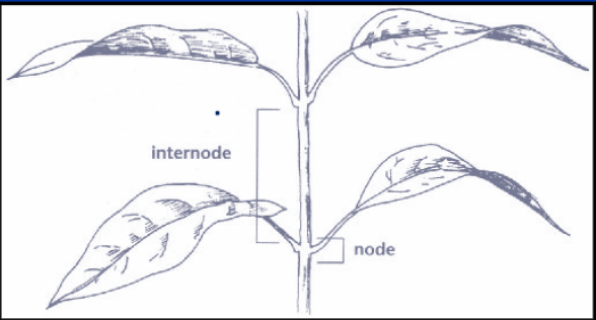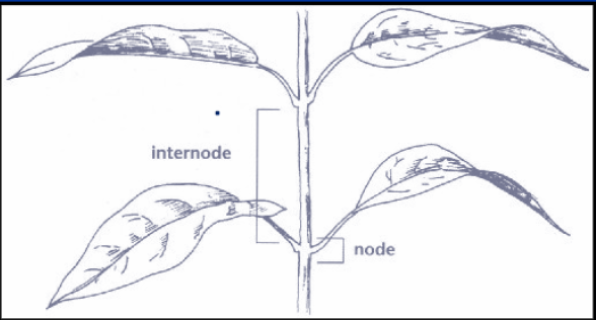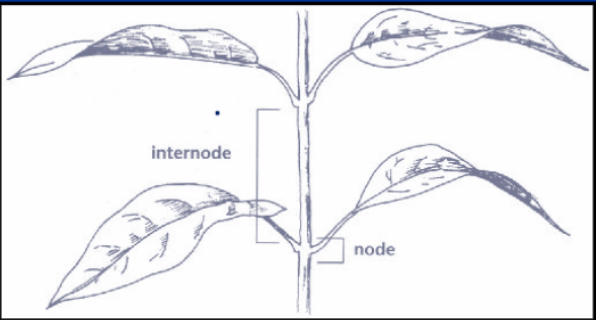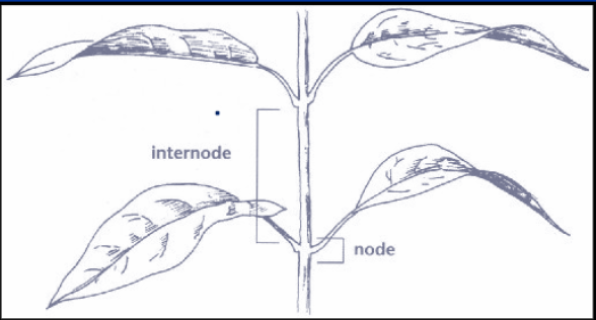Intro Horticulture Exam 2
1/88
There's no tags or description
Looks like no tags are added yet.
Name | Mastery | Learn | Test | Matching | Spaced |
|---|
No study sessions yet.
89 Terms
Seed Germination Requirements
Water, oxygen, optimal temperature, light, and lack of chemical dormancy.
Phytochrome
A photoreversible plant pigment that exists in active and inactive forms, controlling physiological activities like germination and flowering.
Hormones are
chemical messengers produced in localized regions that translocate to communicate body function and growth orders.
Hormones control
Metabolism, hunger, development and growth
PGRs
Hormones which are naturally occurring compounds produced in small quantities with powerful effects on plant growth. Usually produced in one part of the plant and translocated to another part of the plant where they act.
How do hormones move in a plant?
Hormones diffuse throughout the plant to promote growth and development.
When under water stress:
A hormone known as ABA will move from the roots to the shoots. Stomates (pores in leaves) close to limit water loss as well.
Plant hormones allow plants to respond to changes in what factors?
Light, temperature, soil moisture, and relative humidity
What are the 5 classes of Plant Hormones?
Abscisic acid (ABA), auxins (IAA), cytokinins (CK), ethylene (E), gibberellins (GA)
Types of PGRs
Natural and synthesized
What PGRs are natural?
Natural Compounds or Plant Hormones, ie.IAA (AUXIN)
What PGRs can be synthesized?
Synthetic compounds ie. IBA, 2, 4-D
What are auxins?
Plant hormones that control phototropism, geotropism, prevent tillering, promote rooting, and can act as herbicides.
What is the role, site, and effect of auxin?
Auxin’s role is cell elongation and controlling apical dominance. It is produced at the shoot tips, and affects plant growth in response to the environment as well as helping to produce roots.
What is pinching?
The intentional removal of the apical bud to encourage lateral branching
How will cutting a shoot tip off a plant stimulate its growth?
The shoot tip inhibits the growth of lateral buds or tillers due to the presence of auxin. If you cut off the shoot tip, the lateral buds or tillers grow out, If you replace a shoot tip with IAA (auxin) , no tiller growth will occur.
Apical Dominance
The phenomenon in plants where the main, central stem of the plant grows more strongly than the other lateral stems or branches leading to growth patterns. This growth pattern occurs due to the influence of auxins, which are produced in the apical bud and inhibit the growth of lateral buds. This mechanism allows the plant to prioritize vertical growth towards sunlight and helps in maximizing light capture for photosynthesis. When the apical bud is removed or damaged, the inhibition on lateral buds is lifted, leading to increased branching.
Before and After Pinching
Before:only two leaves in coming from center stem
After: doubled growth, so four leaves total coming from center.
what PGRs are used to promote rooting of cuttings?
Indole Butyric acid (IBA) and Naphhthalene acetic acid (NAA) (used as a powder or liquid)
How do IBA and NAA promote rooting in cuttings?
IBA and NAA promote rooting by stimulating root cell differentiation and elongation at the cut end of the cutting. They enhance the formation of adventitious roots, which are roots that develop from non-root tissues. These hormones help in activating the plant's physiological processes related to root initiation and growth, leading to better establishment of the cutting.
How do auxins promote fruit growth, specifically in tomato plants when auxin is applied to the stigma?
Applying auxins to the stigma of tomato plants help ensure that the pollen reaches the ovules effectively by promoting pollen tube growth. Once fertilization occurs, auxins produced in the ovule help trigger fruit development from the ovary. This process is essential for the formation of healthy tomatoes. Auxins applied to the stigma also help to prevent the premature dropping of flowers and fruits, ensuring that more flowers develop into mature fruits.
What happens when levels of auxin in a plant are not controlled?
Tumors and twisted growth can occur
What is 2,4-D?
An auxin based selective herbicide that kills broadleaf weeds in turf and causes more leaf strapping but can be broken down by monocots
what is leaf strapping?
curling leaves, which can impede photosynthesis.
Gibberellins
Plant hormones that control plant height, stimulate seed germination, and promote shoot and seed growth.
What is the role, site, and effect of Gibberellin?
The role of gibberellin is to control internode elongation (height) and it is produced in the root and shoot tips. It controls yearly cycles (flowering/ bolting, seeding, and dormancy exiting) and induces rapid growth of stems and seeds
Why are gibberellins important in dwarf mutants?
many dwarf mutants do not make gibberellins so spraying a dwarf mutant with GA promotes internode growth.

Internode
the part between two nodes or joints


Node
the part of the stem where stems leaves and buds emerge or the point at which stems intersect and branch

Types of Plant Growth Retardants
Cell Division inhibitors and GA inhibitors
Ethylene
A gaseous plant hormone responsible for the ripening of fruit and the death of plants (senescence).
Where is ethylene synthesized from?
It can be synthesized from anywhere in the plant and can even diffuse outside the origin plant onto other plants nearby.
What do ethylene inhibitors do?
Delay ripening and improve post-harvest life of fruits and flowers
What is ethephon?
the packaged form of ethylene that will cause the plant to release ethylene inside the cell when ethephon’s are absorbed. Commonly used on turf as a growth retardant and seedhead delayer. Will result in greater number of small leaves. (PROXY)
Why are seedhead on creeping bentgrass (putting green turf) not desired?
They create uneven surface and are viisually unappealing.
Cytokinins (CK)
Plant hormone primarilt controlling cell division. Can be used on turf to maintain green color longer in the fall but may also . increase root growth at any time of the year.
What is the role, site, and effect of cytokinin?
The role of CK is cell division and it is produced at the root tips of plants. It promotes the mitosis of new cells and stimulates seed germination and shoot growth
Auxin vs Cytokinin in Roots and Shoots
Auxin stimulates the production of roots and cytokinin stimulates the production of shoots
what is the effect of iron on green color of turfgrasses?
Adequate levels of iron enhance the chlorophyll synthesis process, leading to deeper green coloration and improved overall plant
What is the effect of CK on green color of turfgrasses?
Cytokinins (CK) enhance the green color of turfgrasses by promoting chlorophyll synthesis and stimulating cell division, leading to healthier, more vibrant foliage.
Abscisic Acid (ABA)
Plant hormone that causes guard cells to close, puts the plant into dormancy, and reduces transpiration.
What is the role, site, and effect of Abscisic Acid?
ABA is responsible for plant dormancy, is produced in chloroplast. Can cause plant leaves to drop off trees, seeds to fall, and the stomata to close to reduce water loss during drought stress
How does ABA reduce transpiration?
Roots make ABA when the soil begins to dry out. ABA is transported to the leaves. ABA enter the guard cells and closes the stomates
What are anti-transpirant drenches?
Drenching soil prior to any expected environmental stress. Use prior to digging, shipping, display, transplanting or extreme weather. One application can protect plants from water stress fir up to three weeks
How is ABA a growth indicator?
ABA increases during seed development to prevent germination in the seed head. Grass seed must be stored for several months before it will germinate because ABA decreases in the seed during storage, which allows for germination.
What is vivipary?
When the germination of seeds occurs while they are still attached to the fruit. (Corn ABA mutants)
What will happen if the amount of cytokinins is greater than Auxin?
Gibberellin goes down so flowers are no longer blooming but abscisic acid goes up, causing leaves to begin to fall.
Propagation
the art and scienc of multiplying plant material from to preserve a given trait
Types of Propogation
Sexual (form seed) and Asexual (cloning)
How is plant propagation done?
Through knowledge of mechanical manipulations and technical skills
Why is plant propagation done?
For knowledge of plant growth and structure and understanding of the underlying reasons for certain propogation procedures and why they are possible.
How is the plant for plant propagation chosen?
Through knowledge of specific plants and the methods through which they must be propagated. It is an art and science
Meiosis results in what?
Gametes and genetically distinct seeds
Does mitosis lead to recombination?
No
What does vegetative propagation rely on? Mitosis or meiosis?
Mitosis
Sexual plant propagation
Results in genetically different offspring but has potential to lose gene of interest. Cheaper and can store seeds longer
Asexual plant propagation
Results in genetically identical offspring and has potential to fix gene of interest. Relies on living plants to clone from and can be expensive
Types of Asexual Plant Propagation
Root cuttings, layering, grafting/budding, and micropropagation/ tissue culture
Rooted Cuttings
A portion of stem, leave, or root from parent plant that when placed under favorable environmental conditions will induce new roots or shoots to form, resulting in identical offspring. More efficient use of space and least expensive method for cloning plants. Produce more uniform crops as well.
When is Layering used?
Used in special occasions when species is valuable to justify expense or is hard to reproduce by other means. Allows for propagation of a small number of large plants for short period of time (3-5 months) outdoors with minimal amount of supplies and facilities. Does not require a greenhouse or mist bench and ensures the cultivar stays on its own roots.
How is layering done?
Start by winding the stem slightly and then spray the liquid root hormone (auxin) and finally add potting mix
Limitations of Cuttings
Not all species root easily or economically and they are dependent on growth phase of plant (mature plants may not root as readily as immature plants). Not all cutting will benefit from certain rootstocks and may have poor anchorage due to weak root systems
Rootstock
a plant onto which another variety is grafted or the primary form or source from which offshoots have arisen. Forms the lower portion of the grafted plant and root system.
What is layering?
A form of rooting cuttings where adventitious roots are initiated on a stem while it is still attached to the plant. The rooted stem is later detached from the parent plant and is established on its own roots
What is grafting?
The art of connecting two pieces of living tissue together so they unite and develop as one
Types of Grafts
Splice graft and slice veneer graft
Scion wood
The variety/cultivar you want to multiply or the stem with one or more buds that forms the upper portion of shoot on a grafted plant
Budding
Form of grafting in which the scion is reduced to a single bud and a small section of the stem
Reasons for grafting
Not all species readily initiate roots from stem cuttings and is more efficient than layering since it requires less time, space, and stock (parent material). Helps to also obtain special forms of plants and obtaining the benefits of certain rootstocks
Limitations of grafting
More expensive than rooting cuttings and requires more land, skillful labor, and facilities. Some plants may also be more difficult to graft as they require special temperatures
Tissue culture propagation
Most expensive, high-risk, but efficient method. Can get millions of plantlets from a single parent source and super space efficient. Difficult to establish pure cultures
Totipotency
The ability of each individual plant cell to differentiate into any of the tissue types
Callus
Scar-like tissue that can transform into roots, shoots, and more callus
Why do root cuttings work?
Plants send out adventitious roots during stress from pre-formed roots or “root buds” when environmental changes trigger a hormone response
Preformed Root Initials
Root buds that erupt into adventitious roots, already differentiated into root tissue.
Scarification
The process of intentionally breaking, damaging, or removing the seed coat to help in germination.
Stratification
The process of exposing seeds to moist and cold temperatures to promote later germination.
What is a seed?
And embryonic plant inside a seed coat with stored energy (protein and carbohydrates)
Monocots
Have one cotyledon, with veins usually parallel and flower parts in multiples of 3. Vascular bundles are scattered
Dicots
Two cotyledons with net-like leaf veins and flower parts in fours or fives. Vascular bundles are in a ring
Cotyledons
The first leaves that appear on a seedling as it emerges from a seed. They serve several key functions like providing initial photosynthesis, storing nutrients for the young plant, and sometimes identifying plant species
How many rounds of meiosis does cross pollination go through?
2 times and results in high heterozygosity and variability
What has the most impact in germination? Light intensity, quality, or duration?
light quality
Tetrazolium (TZ) test
Red stains will indicate live tissue and whether seeds are viable or not (red means yes).
Seed Float Test
Viable seeds sink
Epizoochory
Attached animal seed dispersion
Endozoochory
Seed dispersal inside an animal
The seed embryo is comprised of
The cotyledon(s), epicotyl, and hypocotyl
The seed is comprised of
The embryo, endosperm, radicle, and seed coat